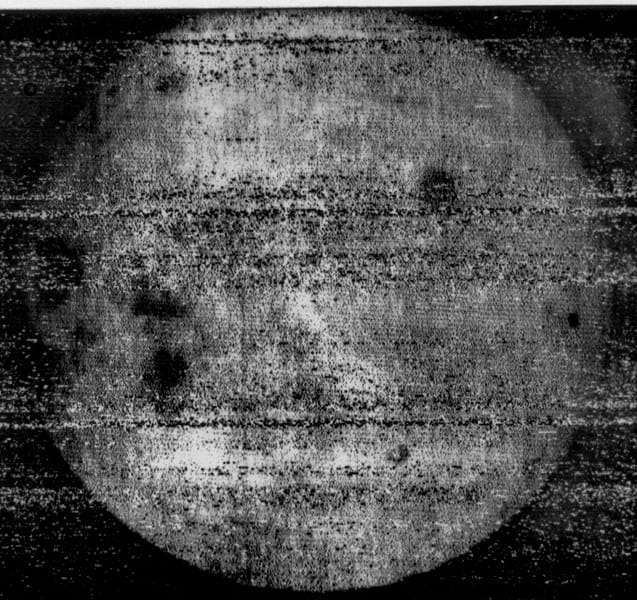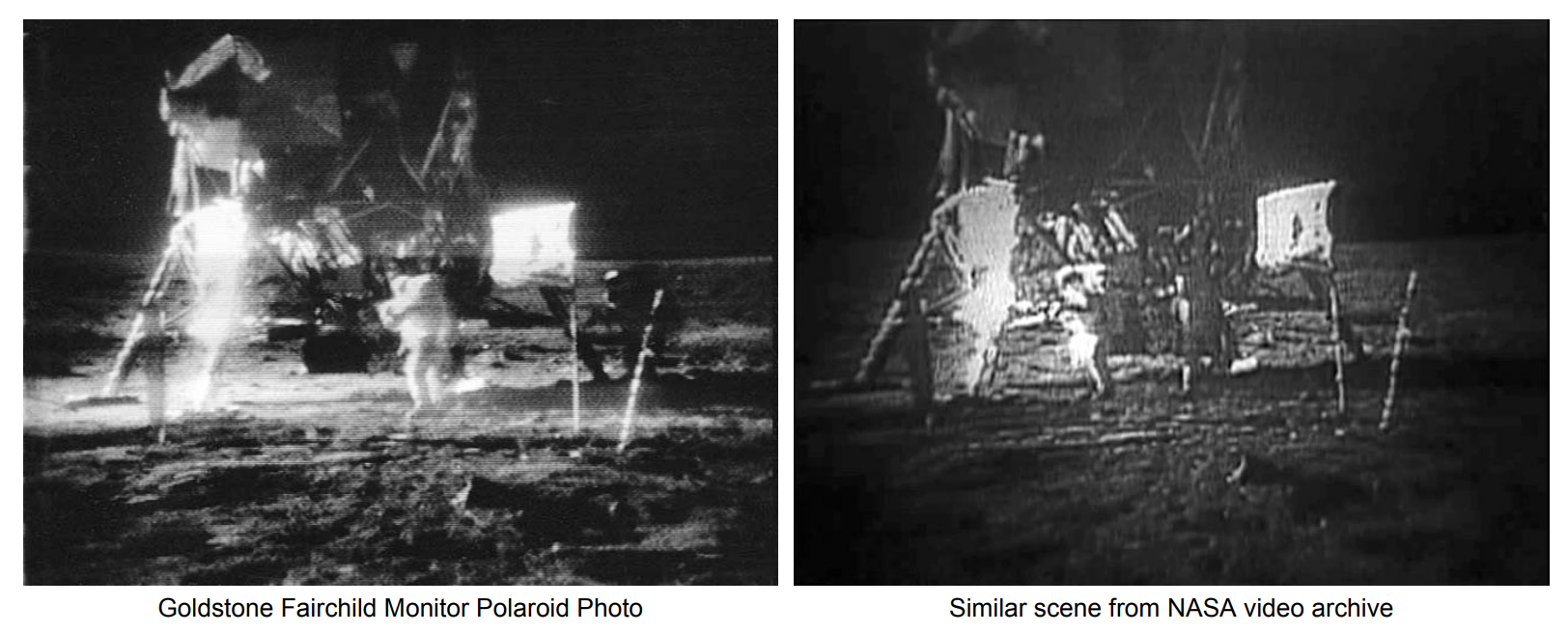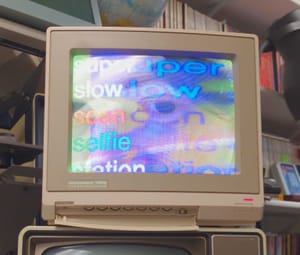When I say “Moon landing on TV,” you likely think of this broadcast, which features grainy, blurry, and dark images of Neil Armstrong descending from the Lunar Module in 1969. I’ve always excused the horrible quality of these images because, well, they’re literally from the moon.
I have never been to space, and most of what anyone knows about space is what we’ve been shown. This ranges from artistic renderings, like those of Don Davis, to images that have been compiled through layers of light spectrum readings, like those made from JWST. Regardless, images of space are always filtered through something – through someone’s imagination, through interpreting a paper, through a computer program, through a camera lens. These things decide what to capture, and they affect how, when, and where the result will be shared.
The crude videos from the moon were broadcast using slow-scan television, which influenced how we came to imagine the surface of the moon. While we all know the moon isn’t literally a shaky video, it's hard to fully separate visual media of the moon from our internal concept of being on the moon, and I’ve been looking into the technologies that form that image.

Slow-scan TV (SSTV) is an image transmission method first used in the late 1950s, which is still used today. SSTV transmits image data over a frequency-modulated signal in the lower frequencies of the electromagnetic spectrum. In other words, it works just like FM radio, except instead of sound, it transmits images.
For much of the twentieth century, basically all analog TV signals were transmitted on the electromagnetic spectrum alongside FM radio. Commercial analog TV uses channels that are 6 MHz wide, which allows it to transmit about 30 images per second. But SSTV only uses 3 kHz of bandwidth, and is much slower; it can take anywhere from a few seconds to a few minutes to transmit a single image. SSTV was developed around the voice frequencies in use for telephones in the 1950s, and as a result it’s possible to decode SSTV signals into audible sounds and vice versa. So just as SSTV can be transmitted via ham radio, you can also play a sound from your computer and use an SSTV receiver to decode it into an image. There are a bunch of different ways to receive and decode SSTV signals, but I’ve had access to a Robot 1200c like this one.
Okay, I get that it's hard to imagine – let's decode an image together. Download an SSTV decoder app to your phone (I like Robot36 Decoder for Android, and CQ SSTV is good for iOS). Open the app, and then use another device to play this sound out loud so your phone can pick it up; the SSTV app should automatically detect the decoder, and will then begin displaying an image, line by line. At the beginning of the recording you can hear a series of frequencies that indicate the decoder model, and each line is punctuated by a specific frequency as well. I’ve listened to so many, I'm basically fluent in Robot36. Once you recognize the sounds, you might hear them in other places, like as a secret puzzle at the end of the videogame Portal.
Much of the early space imagery you know was transmitted by SSTV. A whole variety of systems were used to generate, encode, and transmit images throughout the Apollo missions, which were received by huge antennas on Earth. Apollo-era data transmission used a system called Unified S-Band, which combined voice, biomedical, and telemetry data from both the Command Module (which was circling the Moon) and the Lunar Module (which landed on it). After all of these signals were accounted for, this left 700 kHz of bandwidth to send a narrowband TV signal. The Apollo TV system used 320 horizontal lines at 10 frames per second, which was only a fraction of the standard 30 FPS broadcast television format of the time.
Before Apollo, SSTV was also used in the Soviet Union, including in the 1959 Luna 3 mission which took the first photos of the far side of the moon. It was used during Sputnik 5 to transmit images of space dogs Belka and Strelka, and today you can still receive SSTV images from the ISS on 145.800 MHz FM.
But the infamous moon landing broadcast is particularly unique, and is much blurrier than other SSTV footage. Because of the difference in frame rate between SSTV and NTSC, the live transmission had to be converted into a digital signal to comply with broadcasting standards. This optical conversion greatly reduced the quality of the image, which wasn’t a big issue for the public, as it's easy to accept what we are being shown as truth. While the broadcast was recorded by thousands of people around the world, and even by the receiving ground stations, the original tapes were lost by NASA archives sometime in the 1980s. Those involved are fairly certain that official recordings were made, but in the intensity of the later Apollo missions, documentation was just not a priority – which is really wild to me. Some of the only high quality images of the moon landing are from Polaroid photos taken of the SSTV monitor at the ground station where the image was received.

The reason I’m writing about SSTV in the first place is because it shaped some of the most well known images of the Moon, and its quirks helped manufacture popular understanding of what it might be like to live on another planet. SSTV was developed to address concerns inherent in space exploration: Political leaders and the public desperately want to see images from space, but physical media don’t always make it back to Earth and the bandwidth available for real-time communication can be limited due to vast distances and there not always being direct line of sight. SSTV fit these needs perfectly, and the images it helped to communicate sparked the works of fiction, art, and technical discussions that exploded in the 1960s/70s around leaving this planet, like the L5 Society I’ve written about before. SSTV videos also helped consolidate what we might see in the night sky with a real, actual place. Because of its limited resolution, poor contrast, and lack of detail (made worse by the loss of the archived material) SSTV has made the moon landing recordings into perfect fodder for conspiracy theorists and sci-fi authors alike. The grainy, dark spaces in the shadows and background of all of these images lends itself to having ideas and speculation being projected into it: what is being hidden in the background, what are we not being shown?
There was another broadcast camera aboard Apollo 11 that had an impact on our understanding of the Moon landing. The black and white camera that recorded Armstrong’s first steps was designed to be able to function with minimal setup, but a color camera was set up later. The color camera was able to capture a narrow palette of colors available on the moon, from the grays and black of the rocks to the gold and yellows of the lunar module shielding. It's interesting to consider that most of the color in these images comes from human-created objects, and makes me wonder what the purpose of a color broadcast camera was. Most notably, the waving US flag – which has become iconic, as both a symbol of patriotism and a hook for conspiracy theorists – pops against the stark backdrop of the moon.
Both cameras had to be able to operate between -40°C and 130°C, and could only use 7 watts of power (less than a pretty dim lightbulb). If you're curious, the Lunar TV Operations manual goes into detail about how it all worked. There were also a variety of still cameras used on the Apollo missions in addition to the broadcast cameras. Most famously, the Hasselblad 70-millimeter EDC, nicknamed “Hassies,” were responsible for the majority of the still images physically returned from the Apollo missions. You can find all of the Apollo mission photos here. My favorite are these lunar panoramic images from the later missions, which used a camera mounted to the command module that was orbiting the moon. Any map of the moon you’ve seen has come from these orbital photos.
Technologies used to create images of space continue to influence our imagination, even when it feels like they are directly relaying information. I’m currently working on an art exhibition where people can use a real SSTV transmission to populate the dark, blurry, or ambiguous parts of images from Apollo missions with their own ideas of the future, through what I call a Super Slow Scan Selfie Station. I’m hoping by highlighting how these iconic images were produced, and letting people experiment with them, that they will be prompted to consider the role media production plays in our imagination. What I find most interesting about images from outer space or even those from other space probes or satellites, is how they create places for us to imagine an escape from Earth, or life on a better world.
SCOPE CREEP.
- I was recently reminded of another vintage media transmission device: HitClips, an early 2000s way of listening to music that uses cartridges with a single song on them. One thing I realized while playing with them is the completely lost audio aesthetic of dying batteries, which hit some deep nostalgic memories for me. I know I’m not the only one who is obsessed with exploring these old devices, because I recently came across these Homebrew HitClips, which shows you how to create your own cartridges. Some of my other favorite late 90s/early 00s listening devices include SoundBites and ToothTunes, which both use bone conducting devices to play your own personal tunes through your mouth!
- There are a variety of technologies that predate SSTV, and that work in a very similar way. Facsimiles, which we all know from everyday fax machines, work by scanning physical documents line by line, encoding them into an electrical signal and transmitting it through phone lines or radio waves. One of my favorite facsimile devices is called Hellschreiber, a simple teleprinter with few moving parts. Hellschreiber prints characters onto the screen without encoding or decoding a signal, unlike other teletype modes. It was used during World War II by the German military with the Enigma encryption system.
Thanks as always to Scope of Work’s Members and Supporters for making this newsletter possible. Thanks also to libi, Lori, and Darja at the MAL for their kindness, assistance, and curiosity!
Love, Lee
p.s. - Reply to this email and send me your SSTV encodings!
p.p.s. - We care about inclusivity. Here’s what we’re doing about it.




